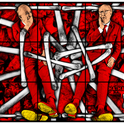Hadouken! That's an exclamation that, to many Prospect readers, will mean exactly nothing. To the rest of us it means duck, jump or block. It's the sound with which a character in the computer game Street Fighter announces that he's just thrown a fireball at you.
If we're serious about paying attention to emergent cultural forms, the release this spring of Street Fighter 4 deserves a moment of our attention. The Street Fighter games are a significant part of the culture. A good portion of my generation spent adolescence and young adulthood hammering away at SF2 in the arcades and, later, on consoles. Its roster of playable characters is more familiar and resonant to many than the character line-up of Chaucer's general prologue. And the game essentially established the model for a whole genre: the two-player "beat-em-up," where each player controls a character with his or her own set of special moves and attacks, and these characters beat seven bells out of each other in two dimensions.
What's interesting about this new version is that, 20-odd years on (with all that implies for Moore's law), and running on some of the most sophisticated hardware available, Street Fighter 4 is in all its important essences exactly the same as its predecessors. This is curious because the history of videogame evolution is generally one of advancing complexity. First-person shooters, for instance, have gone from two dimensions to three, acquired elaborate plots, complex artificial intelligence routines and realistic physics. Street Fighter—which went through a couple of unsuccessful 3D iterations before returning in more or less canonical form—has done the reverse. Like Tetris—that other obdurate triumph of simplicity—it runs best on the flat.

I am not writing from a position of gameplay expertise. My games of Street Fighter 4 last about 40 seconds unless I play in a training mode in which my opponent is the equivalent of a crash-test dummy. Even then, I get stuck. I can't do anything harder than fling the odd accidental fireball. My thumbs hurt. My neural pathways are fritzed. I haven't the chops for it.
Compare the performance of the top-ranked player Daigo Umehara in a 2004 tournament. Umehara is playing the judo-suited character called Ken. His opponent, Justin Wong, is playing the high-kicking Chinese fighter Chun-Li (along with Lara Croft, one of the most enduring lust-objects in videogames). In the final round, Wong is well ahead. Umehara's health bar has been wiped out. At this point, Wong launches one of Chun-Li's special attacks, the houyokusen: a flurry of kicks at different heights from the right leg, then a flurry of kicks at different heights from the left leg, then a jaw-breaking straight-legged kick directly upwards. In addition to showing you Chun-Li's knickers, this attack deals a formidable amount of damage even when blocked.
Wong has to be pretty co-ordinated to make this attack in the first place—it involves two precise quarter turns of the joystick in quick succession, and a well-timed button press. But in the next second and a half or so, Umehara manages to parry every single one of the dozen or so blows the move involves, the last one from the air—and then retaliates with a 12-hit combination that wipes his opponent out. This video is all over YouTube and the comments beneath are as reverential as the site gets. Their unfailing gist is: "OMFG that's fucken ill, d00d." That's quite proper. Umehara's moves are the equivalent, as a colleague remarked the other day, of watching a Premiership goalkeeper make a save by catching the ball on his head.
As the web designer Tom Armitage notes on his blog, Infovore, it's all about systems literacy: about knowing a system so well that you're planning your next move based on an understanding not just of what your opponent is currently doing, but also of the tree of decisions available to them. Umehara wasn't simply reacting to Wong's houyokusen—he was anticipating it. And that, finally, is why this game doesn't change. Played at 60 frames a second, Street Fighter 4 is, as one gamer put it to me: "very basically, the most complicated game of scissors-paper-stone you will ever have seen."












